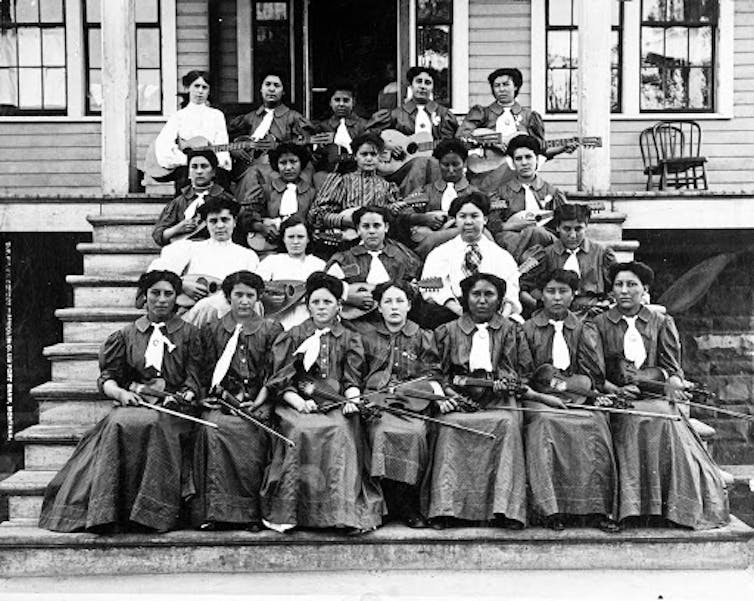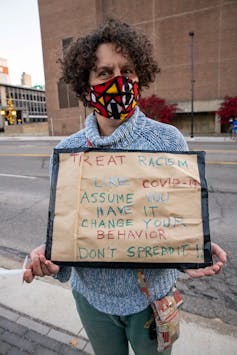White supremacists who stormed US Capitol are only the most visible product of racism
- Written by Ursula Moffitt, Postdoctoral Fellow in Psychology, Northwestern University
Among the Trump supporters who stormed the U.S. Capitol on Jan. 6 were members of right-wing groups[1], including the Proud Boys, Oath Keepers and Three Percenters.
The increasing violence and visibility of these groups have turned them into symbols of white supremacy and racism. They were involved in the deadly Unite the Right[2] march in Charlottesville, Virginia, in 2017 and street clashes[3] with racial justice protesters in Portland, Oregon, last year. At a Trump rally in Washington, D.C., in December, Black Lives Matter banners[4] were torn from two historically Black churches and destroyed. The Proud Boys’ leader has been criminally charged in those acts[5].
Many Proud Boys reject the label “white supremacist”[6], arguing their aim is to “save America[7]” and to defend “Western values[8].”
White supremacy was itself a longstanding Western value. And white people don’t have to be white supremacists to benefit from the ways it still shapes American society.
White supremacy, then and now
As an ideology, white supremacy[9] is the belief that white people are inherently superior to people of color. It relies on the notion that distinct races of people exist, and ranks those categorized as “white” at the top of the racial hierarchy[10].
For hundreds of years, American leaders overtly embraced white supremacy. It was used to rationalize[11] the genocide of Native Americans and the enslavement of Africans and their descendants from the Colonial period to the 19th century. In an 1858 debate, President Abraham Lincoln said[12], “I am not, nor ever have been, in favor of bringing about in any way the social and political equality of the white and black races.”
Known for abolishing slavery, Lincoln’s position may come as a surprise. But many U.S. abolitionists wanted white people to maintain power[13] in government and everyday life, including after Black people were freed from bondage.
After abolition in 1865, white supremacy continued in official and unofficial ways. It drove the legal racial segregation of Jim Crow[14] and the banking practice of redlining[15], which robbed Black families of the loans necessary to buy homes in certain neighborhoods. White supremacy also underlay the forced assimilation[16] and killing of Native Americans[17].
 Boarding schools for Native American youths, like Montana’s Fort Shaw, cut students off from their culture and taught them that white values, practices and dress were American culture.
Montana Historical Society Photo Archives, CC BY[18][19]
Boarding schools for Native American youths, like Montana’s Fort Shaw, cut students off from their culture and taught them that white values, practices and dress were American culture.
Montana Historical Society Photo Archives, CC BY[18][19]
Outright racist policies were banned after the civil rights era of the 1960s. But systemic racism remained[20]. Today’s well-documented inequalities[21] between Black and white Americans in savings, longevity, home ownership and health are directly related to the white supremacist hierarchy created centuries ago.
Hidden white supremacy
White people need not endorse white supremacy to benefit from this hierarchy. As psychologist Beverly Tatum[22] has explained, the privileges afforded to whiteness are so much a part of the structure of U.S. society that many white people don’t even notice them.
 Decrying the insidiousness of white supremacy at a protest march.
Stephen Zenner/SOPA Images/LightRocket via Getty Images[23]
Decrying the insidiousness of white supremacy at a protest march.
Stephen Zenner/SOPA Images/LightRocket via Getty Images[23]
For example, a white man is unlikely to be stopped and frisked by police[24]. A white high school student probably won’t be asked if she’s in the right room on the first day of an honors class[25]. And it likely won’t occur to either to reflect on these privileges.
A white person is similarly unlikely to wonder why no one ever asks “but where are you really from?[26]” after introducing themselves. And a white child likely won’t notice that nearly everyone in their textbooks[27] looks like them.
All of these affronts, both minor and major, are experiences many people of color face throughout their lives.
Not noticing one’s racial privilege does not make a white person a white supremacist. That racial privilege affects countless aspects of daily life does, however, mean that U.S. society is still shaped by white supremacy.
All people have a racial identity
Research shows[28] that white people must recognize and understand how they benefit from white supremacy to combat it. Doing so necessitates an awareness of one’s own racial identity – which is something I study[29] as a developmental psychologist.
In general, white people easily identify as white[30] on official forms or in research settings. But when asked about their racial identity – that is, the way they understand themselves in terms of race and their experiences as a member of their racial group – they often have trouble answering[31].
For example, in ongoing interview-based research with white teenagers, my colleagues[32] and I ask questions like, “How important is being white?” and “What does it mean to be white?” The teens generally claim their race “doesn’t really matter.”
This response reflects a tendency to think of whiteness as normal and invisible[33], and race as something “other” people have.
Yet many of these same white teenagers also told us stories of witnessing racism in their schools and within their friend groups. They can see and name obvious racism, but most do not recognize their own white privilege as a part of the same system.
For that reason, although racism is often seen only as prejudiced beliefs and behaviors – as embodied by the Proud Boys and other such groups – it is better defined as a system of advantage based on race[34]. Most teenagers in our study do not endorse racism, but they are all growing up in, and benefiting from, a society shaped by it.
If and how white people acknowledge that fact informs their own identities – and affects the society they forge. Research shows people who recognize the history of racism are more likely[35] to identify racism today, in both overt forms like the violence at the Capitol and in more covert daily forms.
Extremists like the Proud Boys[36] are putting American white supremacy in the headlines today, just as the Ku Klux Klan did 50 years ago. But they are merely its most visible product.
References
- ^ right-wing groups (www.propublica.org)
- ^ Unite the Right (time.com)
- ^ street clashes (www.washingtonpost.com)
- ^ Black Lives Matter banners (www.nbcwashington.com)
- ^ criminally charged in those acts (slate.com)
- ^ reject the label “white supremacist” (www.usatoday.com)
- ^ save America (www.youtube.com)
- ^ Western values (www.wisconsinwatch.org)
- ^ white supremacy (www.washingtonpost.com)
- ^ racial hierarchy (psycnet.apa.org)
- ^ used to rationalize (www.tandfonline.com)
- ^ President Abraham Lincoln said (www.aaihs.org)
- ^ white people to maintain power (www.npr.org)
- ^ legal racial segregation of Jim Crow (www.history.com)
- ^ banking practice of redlining (www.npr.org)
- ^ forced assimilation (www.history.com)
- ^ killing of Native Americans (www.history.com)
- ^ Montana Historical Society Photo Archives (lh3.googleusercontent.com)
- ^ CC BY (creativecommons.org)
- ^ systemic racism remained (theconversation.com)
- ^ well-documented inequalities (theconversation.com)
- ^ psychologist Beverly Tatum (www.pbs.org)
- ^ Stephen Zenner/SOPA Images/LightRocket via Getty Images (www.gettyimages.com)
- ^ stopped and frisked by police (www.nytimes.com)
- ^ honors class (www.theatlantic.com)
- ^ but where are you really from? (www.cnn.com)
- ^ everyone in their textbooks (www.vox.com)
- ^ Research shows (psycnet.apa.org)
- ^ something I study (scholar.google.com)
- ^ identify as white (psycnet.apa.org)
- ^ they often have trouble answering (www.tandfonline.com)
- ^ my colleagues (scholar.google.com)
- ^ normal and invisible (oxfordre.com)
- ^ a system of advantage based on race (www.pbs.org)
- ^ more likely (journals.sagepub.com)
- ^ Extremists like the Proud Boys (www.wisconsinwatch.org)
Authors: Ursula Moffitt, Postdoctoral Fellow in Psychology, Northwestern University

